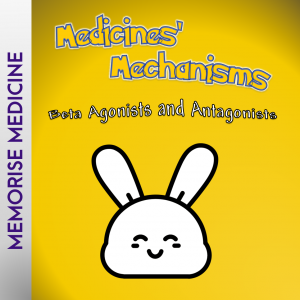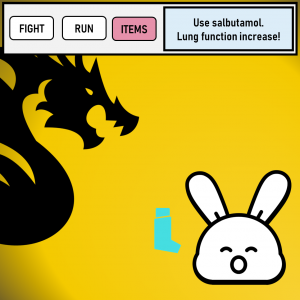
When we are studying Beta agonists and antagonists, sometimes we forget that beta receptors have a normal physiological function in the body – they are not there just to be activated by drugs.
Beta adrenergic receptor exist in three different forms: beta-1, beta-2, and beta-3. And as the name adrenergic suggest these are activated in the body via adrenaline and noradrenaline. This makes it easier to remember what happens when a beta receptor is activated (whether by a drug or as a normal physiological response) as you just need to think what happens in the fight or flight response.
Beta-1 receptors

Beta-1 receptors are located primarily in the heart and mediate cardiac activity. And as such during a fight-or-flight response, we would expect an increase in cardiac output, BP and heart rate. As this would help us fight or run.
Cardioselective beta-blockers (block beta1 receptors) then, of course, would do the opposite – reduce heart rate, BP and cardiac contractility. This is why beta-blockers are indicated for hypertension, angina and tachyarrhythmias.

Beta-2 receptors

Beta-2 receptors are mainly located in smooth muscle cells, such as those found in the lungs and blood vessels. In the bronchi, activation of beta-2 relaxes bronchial smooth muscle, which facilitates respiration. In the body’s natural fight-or-flight response, beta-2 receptors are activated to increase oxygen flow during times of stress. Hence, beta-2 agonists (e.g. salbutamol), are commonly used in the treatment of respiratory conditions like asthma and COPD. On the other hand, beta-2 antagonists (or non-selective beta-blockers) which block the beta-2 receptors, can cause bronchoconstriction, making respiratory conditions worse.

Beta-3 receptors

Beta-3 receptors have a unique distribution in the body, with locations in both adipose tissue and the smooth muscle of the bladder. Beta-3 receptor activation in the bladder relaxes its smooth muscle. Notably, during stressful fight or flight situations, the relaxation of smooth muscle in the bladder caused by beta-3 receptor activation leads to an increase in bladder capacity, allowing for a delay in urination. Hence why, mirabegron, a beta-3 agonist, is used to treat overactive bladder by stimulating beta-3 receptors in the bladder, relaxing its smooth muscle, increasing capacity, and reducing the urgency to urinate.


Study the easy way
- Hundreds of flash cards
- Study tips
- Based on the science of learning
- 100% free
Passing The Pharmacy Australia Intern Oral Exam: The easy way.
Passing The Pharmacy Australia Intern Written Exam: The easy way.
Counselling On Commonly Prescribed Medicines
- Amazon best-selling book
- Exam strategies and study tips.
ORDER NOW: https://shop.memorisemedicine.com/